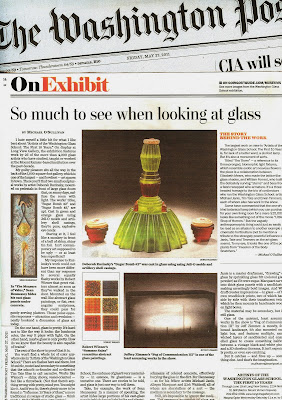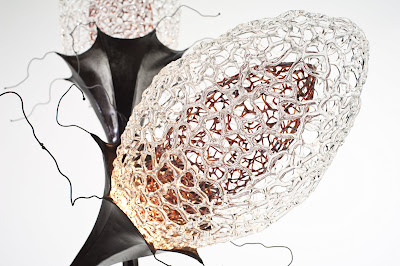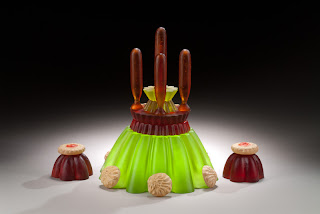>
Sugar Bomb #3; Cast glass, 2011
Debra Ruzinsky
Bombshell, 2011
Debra Ruzinsky‘s cast glass artwork was recently praised by the Washington Post Art Critic Michael O’Sullivan in a review of glass sculpture that was on exhibit at Long View Gallery. In the review, Michael wrote: “My guilty pleasure sits all the way in the back of the 5,000-square-foot gallery… There you’ll find two small sculptural works by artist Deborah Ruzinsky, mounted on pedestals in front of large glass doors that, on sunny days, suffuse the room with light. The works’ titles, “Sugar Bomb #2” and “Sugar Bomb #3,” are apt. Cast in green and orange glass using Jell-O molds and artillery shell casings, they’re pure, explosive eye candy.
Staring at it, I feel like a monkey in front of a ball of shiny, shiny tin foil. Isn’t contemporary art supposed to be ugly — or at least less superficial?…
On the one hand, glass is pretty. It’s hard not to like the way it looks: the luminous color, the way it plays with light. On the other hand, maybe glass is only pretty. How do we know that the beauty is also capable of brains? The rest of the show is proof that it is.”
Debra checks her cast glass wafer ramp for smoothness.
Check back later for links to the Brattleboro Museum show.
Washington Post asks "Is Glass Only Pretty?"
>
 Washington Post reviews Washington Glass School 10th Anniversary Show at Long View Gallery
Washington Post reviews Washington Glass School 10th Anniversary Show at Long View Gallery
The Washington Post newspaper arts critic Michael O’Sullivan has a lengthy review of the Long View Gallery 10th Anniversary exhibition : Artists of the Washington Glass School – The First 10 Years. Michael finds artworks that move him and question if contemporary art must be ugly – if only to be less superficial.
In his review of the retrospective show, Michael O’Sullivan writes: “On the one hand, glass is pretty. It’s hard not to like the way it looks: the luminous color, the way it plays with light. On the other hand, maybe glass is only pretty. How do we know that the beauty is also capable of brains? The rest of the show is proof that it is”…“For the artists of the Washington Glass School, the embrace of glass’s very materiality — in essence, its glassiness — is a tentative one. There are stories to be told, and glass is just one way to tell them.”…
 Jeff Zimmer “Fog Of Communication III” photo by anythingphoto.net
Jeff Zimmer “Fog Of Communication III” photo by anythingphoto.net
And of artist Jeff Zimmer’s work, Michael writes:
“One of the quietest, least assuming works in the show is “Fog of Communication III” by Jeff Zimmer. A moody, fog-bound landscape, it’s also mounted on a light box, and features multiple, sandwiched layers of sandblasted and enamelled glass to create something halfway between a vintage black-and-white photo and a 3D shoebox diorama. It isn’t especially pretty, or even eye-catching.
But it catches — and fires up — something else. And that’s the imagination. “
Click HERE to jump to the full Washington Post article.
The Washington Post also goes into the background story of one of the largest works in the show – “The Three” by Elizabeth Ryland Mears and William “Tex” Forrest.
 Elizabeth Ryland Mears with William Forrest “The Three” photo by anythingphoto.net
Elizabeth Ryland Mears with William Forrest “The Three” photo by anythingphoto.net
 Michael writes “But the vaguely anthropomorphic thing could just as easily be read as an allusion to another example of cinematic horticulture (not to mention a tribute to the strangely powerful influence of Janis, Tate and Timmers on the art-glass scene). To my eye, it looks like one of the pod plants from “Invasion of the Body Snatchers.”
Michael writes “But the vaguely anthropomorphic thing could just as easily be read as an allusion to another example of cinematic horticulture (not to mention a tribute to the strangely powerful influence of Janis, Tate and Timmers on the art-glass scene). To my eye, it looks like one of the pod plants from “Invasion of the Body Snatchers.”
Click HERE to jump to the full Washington Post description of the Liz Mears / Tex Forrest work
 Jennifer Lindstrom What is Home?
Jennifer Lindstrom What is Home?
Click HERE to jump to the Washington Post’s photo gallery of some of the works in the show.
The WGS 10th anniversary show at Long View Gallery will be on exhibit until June 19, 2011.
Featured artists include: Tim Tate, Michael Janis, Erwin Timmers, Elizabeth Mears, Syl Mathis, Lea Topping, Robert Kincheloe, Alison Sigethy, Dave D’Orio, Anne Plant, Jeffery Zimmer, Teddie Hathaway, Jackie Greeves, Kirk Waldroff, Debra Ruzinsky, Tex Forrest, Diane Cabe, Robert Wiener, Nancy Donnelly, Sean Hennessey, Cheryl Derricotte, Jennifer Lindstrom, Michael Mangiafico, Allegra Marquart and m.l.duffy.
There is an artist talk on Sunday, June 05, from 3-4 pm. There is a 10 Year Anniversary celebration that will be held at the Long View Gallery, Sunday, June 19, from 2-5 pm.
Washington Glass School: The First 10 Years
LongView Gallery
1234 9th Street, NW, Washington, DC
Washington Post on Renwick Craft Invitational
>The Post arts critic Michael O’Sullivan has a very insightful review of the Renwick Craft Invitational.
Of the work shown by Judith Schaecter, Michael writes: “… I stood at that midpoint for several minutes, listening to the reaction of random visitors as they crossed the unseen threshold.
“Now this is disturbing” was a typical comment. “It’s a nightmare” was another. Both statements, I would like to believe, were intended as compliments.
The artwork inspiring such strong sentiments is by Schaechter, whose postmodern twist on the stained-glass window has more in common with comic books — albeit darkly subversive, R-rated ones — than ecclesiastical decoration.
Death, arson and lust are just a few of the themes of Schaechter’s bold and striking, if ambiguously narrative, works. Mounted in softly luminous lightboxes, Schaechter’s pictures transform the part of the Renwick where they’re hung into a church of the weird and wonderful. They’re easily the most powerful, and disturbing, things in the show…”
Click here to read the full review.
The Craft Invitational exhibition (March 25 thru July 31, 2011) features works by four extraordinary artists, who are creating works of superior craftsmanship that address the classic craft notion of function without sacrificing a contemporary aesthetic:
- Cliff Lee (b. 1951), a former neurosurgeon who works in Stevens, Pennsylvania, creates elegant porcelain vessels with the exactitude of a doctor, often using his knowledge of chemistry to re-create medieval Chinese glazes long thought lost to history.
- Matthias Pliessnig (b. 1978), a furniture maker in Philadelphia, uses boat-building techniques in new ways to create graceful forms with curved wood strips that may have up to 5,000 points of contact without the aid of hardware.
- Judith Schaechter (b. 1961), a glass artist based in Philadelphia, brings a wealth of knowledge about traditional stained-glass practice to her moody windows.
- Ubaldo Vitali (b. 1944), a fourth-generation silversmith and master conservator of historic silver working in Maplewood, New Jersey, uses classical techniques he learned in Rome to create luminous works for popes, kings, and presidents.
The Renwick Craft Invitational is a biennial exhibition series established in 2000 to honor the creativity and talent of craft artists working today.
Washington Post on CraftWeek DC
>
 The Washington Post Weekend Section has a great article by Michael O’Sullivan. Michael’s article has Tim Tate listing the upcoming CraftWeek DC events. Here is an excerpt:
The Washington Post Weekend Section has a great article by Michael O’Sullivan. Michael’s article has Tim Tate listing the upcoming CraftWeek DC events. Here is an excerpt:
“We’d call him the Craft Whisperer, except that Tate never whispers. “
For the entire article – click here
photographs by Dominic Bracco II

